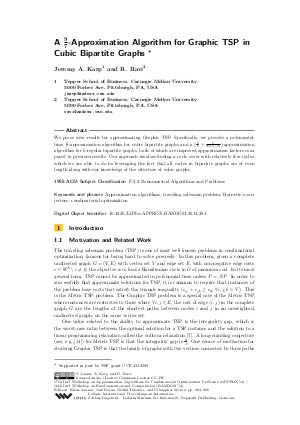A 9/7 -Approximation Algorithm for Graphic TSP in Cubic Bipartite Graphs
Authors Jeremy A. Karp, R. Ravi
-
Part of:
Volume:
Approximation, Randomization, and Combinatorial Optimization. Algorithms and Techniques (APPROX/RANDOM 2014)
Part of: Series: Leibniz International Proceedings in Informatics (LIPIcs)
Part of: Conference: International Conference on Randomization and Computation (RANDOM)
Part of: Conference: International Conference on Approximation Algorithms for Combinatorial Optimization Problems (APPROX) - License:
 Creative Commons Attribution 3.0 Unported license
Creative Commons Attribution 3.0 Unported license
- Publication Date: 2014-09-04
File

PDF
LIPIcs.APPROX-RANDOM.2014.284.pdf
- Filesize: 0.51 MB
- 13 pages
Document Identifiers
Subject Classification
Keywords
- Approximation algorithms
- traveling salesman problem
- Barnette’s conjecture
- combinatorial optimization
Metrics
- Access Statistics
-
Total Accesses (updated on a weekly basis)
0PDF Downloads0Metadata Views
Abstract
We prove new results for approximating Graphic TSP. Specifically, we provide a polynomial-time 9/7-approximation algorithm for cubic bipartite graphs and a (9/7+1/(21(k-2)))-approximation algorithm for k-regular bipartite graphs, both of which are improved approximation factors compared to previous results. Our approach involves finding a cycle cover with relatively few cycles, which we are able to do by leveraging the fact that all cycles in bipartite graphs are of even length along with our knowledge of the structure of cubic graphs.
Cite As Get BibTex
Jeremy A. Karp and R. Ravi. A 9/7 -Approximation Algorithm for Graphic TSP in Cubic Bipartite Graphs. In Approximation, Randomization, and Combinatorial Optimization. Algorithms and Techniques (APPROX/RANDOM 2014). Leibniz International Proceedings in Informatics (LIPIcs), Volume 28, pp. 284-296, Schloss Dagstuhl – Leibniz-Zentrum für Informatik (2014)
https://doi.org/10.4230/LIPIcs.APPROX-RANDOM.2014.284
BibTex
@InProceedings{karp_et_al:LIPIcs.APPROX-RANDOM.2014.284,
author = {Karp, Jeremy A. and Ravi, R.},
title = {{A 9/7 -Approximation Algorithm for Graphic TSP in Cubic Bipartite Graphs}},
booktitle = {Approximation, Randomization, and Combinatorial Optimization. Algorithms and Techniques (APPROX/RANDOM 2014)},
pages = {284--296},
series = {Leibniz International Proceedings in Informatics (LIPIcs)},
ISBN = {978-3-939897-74-3},
ISSN = {1868-8969},
year = {2014},
volume = {28},
editor = {Jansen, Klaus and Rolim, Jos\'{e} and Devanur, Nikhil R. and Moore, Cristopher},
publisher = {Schloss Dagstuhl -- Leibniz-Zentrum f{\"u}r Informatik},
address = {Dagstuhl, Germany},
URL = {https://drops.dagstuhl.de/entities/document/10.4230/LIPIcs.APPROX-RANDOM.2014.284},
URN = {urn:nbn:de:0030-drops-47034},
doi = {10.4230/LIPIcs.APPROX-RANDOM.2014.284},
annote = {Keywords: Approximation algorithms, traveling salesman problem, Barnette’s conjecture, combinatorial optimization}
}
Author Details
References
-
Nishita Aggarwal, Naveen Garg, and Swati Gupta. A 4/3-approximation for TSP on cubic 3-edge-connected graphs. arXiv:1101.5586, 2011.

-
David W Barnette. Conjecture 5. Recent Progress in Combinatorics, 343, 1969.

-
Sylvia Boyd, René Sitters, Suzanne van der Ster, and Leen Stougie. TSP on cubic and subcubic graphs. In Integer Programming and Combinatoral Optimization, pages 65-77. Springer, 2011.

-
Nicos Christofides. Worst-case analysis of a new heuristic for the travelling salesman problem. Technical report, GSIA, Carnegie Mellon University, 1976.

-
José R Correa, Omar Larré, and José A Soto. TSP Tours in Cubic Graphs: Beyond 4/3. In Algorithms-ESA 2012, pages 790-801. Springer, 2012.

-
José R Correa, Omar Larré, and José A Soto. TSP Tours in Cubic Graphs: Beyond 4/3. arXiv:1310.1896, October 2013.

-
George Dantzig, Ray Fulkerson, and Selmer Johnson. Solution of a large-scale traveling-salesman problem. Journal of the Operations Research Society of America, pages 393-410, 1954.

-
Uri Feige, R Ravi, and Mohit Singh. Short tours through large linear forests. In Integer Programming and Combinatoral Optimization, pages 273-284. Springer, 2014.

-
David Gamarnik, Moshe Lewenstein, and Maxim Sviridenko. An improved upper bound for the TSP in cubic 3-edge-connected graphs. Operations Research Letters, 33(5):467-474, sep 2005.

-
Shayan Oveis Gharan, Amin Saberi, and Mohit Singh. A randomized rounding approach to the traveling salesman problem. In Foundations of Computer Science (FOCS), 2011 IEEE 52nd Annual Symposium on, pages 550-559. IEEE, 2011.

-
Michel X Goemans. Worst-case comparison of valid inequalities for the TSP. Mathematical Programming, 69(1-3):335-349, 1995.

-
Jeremy Karp and R. Ravi. A 9/7-Approximation Algorithm for Graphic TSP in Cubic Bipartite Graphs. arXiv:1311.3640, November 2013.

-
Tobias Mömke and Ola Svensson. Approximating graphic TSP by matchings. In Foundations of Computer Science (FOCS), 2011 IEEE 52nd Annual Symposium on, pages 560-569. IEEE, 2011.

-
András Sebő and Jens Vygen. Shorter tours by nicer ears: 7/5-approximation for graphic tsp, 3/2 for the path version, and 4/3 for two-edge-connected subgraphs. Combinatorica, 2014.

-
Nisheeth K Vishnoi. A permanent approach to the traveling salesman problem. In Foundations of Computer Science (FOCS), 2012 IEEE 53rd Annual Symposium on, pages 76-80. IEEE, 2012.

